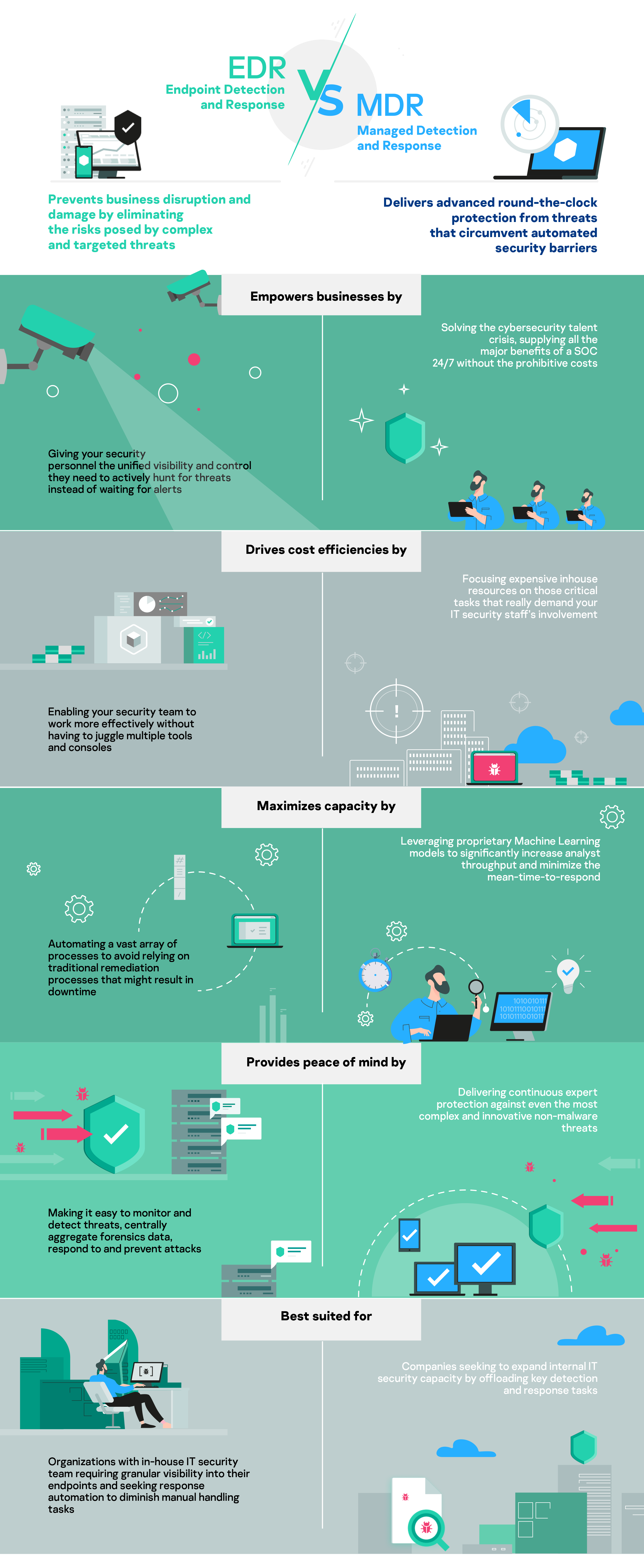Endpoints – meaning, any end of a digital communications connection, like servers, laptops and mobile devices – are cybercriminals’ favorite way to get inside your infrastructure. Market data analysis firm IDC’s 2019 study found 70 percent of breaches started on an endpoint.
There are a few types of threats: traditional, complex or advanced, and targeted or advanced persistent threats (APTs.) Classic Endpoint Protection Platforms (EPPs) do a great job at protecting against traditional threats like malware, but complex or advanced threats are becoming more common as more cybercriminals get hold of advanced tools.
Those digitizing their https://www.kaspersky.com/enterprise-security/endpoint-productbusiness also often want to add a few more security strings to their bow. And these days, cybercriminals aim advanced and complex threats at all kinds of businesses, not just household-name companies and nation states. That’s why adding Endpoint Detection and Response (EDR) to your EPP is fast becoming the standard. And then, Managed Detection and Response (MDR) offers a way to achieve the same protection in a different way. We’ll cover what these advanced options do, their benefits and which types of organizations need them.
What is endpoint detection and response (EDR) and when do you need it?
Once you’ve got an EPP you’re happy with, think about whether you need EDR on top. EDR offers organizations of all sizes greater ability to protect themselves against complex and advanced threats. Although they’re less common than traditional threats, they’re costly and disruptive to business.
EDR gives you better visibility of and instant response to complex threats. It continually monitors endpoints, aiming to identify, investigate and respond.
Your EDR may include tools like advanced detection engines, real-time analytics and the ability to hunt, investigate and centrally respond to evasive threats across the protected infrastructure. There should be applied threat intelligence and visibility into endpoints. Level up your endpoint protection with detection and response gives a full list of what to expect.
EDR gives you tools for visibility, investigation and response. Your team can see what’s happening on all endpoints and understand the scale of the threat. Investigation capabilities let you understand the root cause of a threat. Threat-hunting tools let your cybersecurity experts actively seek out any threats hiding in your infrastructure. After detecting and analyzing the threat, a fast response matters.
Each organization is different. While some might have extensive cybersecurity expertise, others need a simpler solution.
If your business has in-house cybersecurity expertise, you may benefit from better threat discovery, threat hunting and centralized incident response, such as Kaspersky Endpoint Detection and Response, also available as part of Kaspersky Anti-Targeted Attack Platform.
Alternatively, Kaspersky Endpoint Detection and Response Optimum is a simpler solution for the IT department without cybersecurity specialists on hand.
When do you need managed detection and response (MDR?)
EDR provides advanced defensive capabilities, but you need to have your own cybersecurity experts to use it. MDR, on the other hand, means external experts manage your defense.
With MDR, skilled professionals give you continuous protection 24 hours a day, seven days a week. It’s ideal for organizations that struggle to find expertise or with limited in-house resources.
Many organizations that opt for MDR are small- to medium-sized. For large organizations, MDR means you can outsource detecting, validating and prioritizing incidents rather than having as many cybersecurity specialists in house.
If you’re not sure whether EDR or MDR is best for your business, this infographic lays out the benefits of each.
 Endpoints are often vulnerable because they’re what we use to create, communicate and store information. Our people using them can be manipulated by social engineering or make the wrong decision during moments of inattention, so security awareness training will help strengthen your endpoint.
Endpoints are often vulnerable because they’re what we use to create, communicate and store information. Our people using them can be manipulated by social engineering or make the wrong decision during moments of inattention, so security awareness training will help strengthen your endpoint.
But as threats increase, your EPP may not be strong enough. That’s why EDR is fast becoming the new standard. If you don’t have the cybersecurity expertise in house, or want to free them up, MDR lets you bolster your security without the struggle of bringing new people on board.




